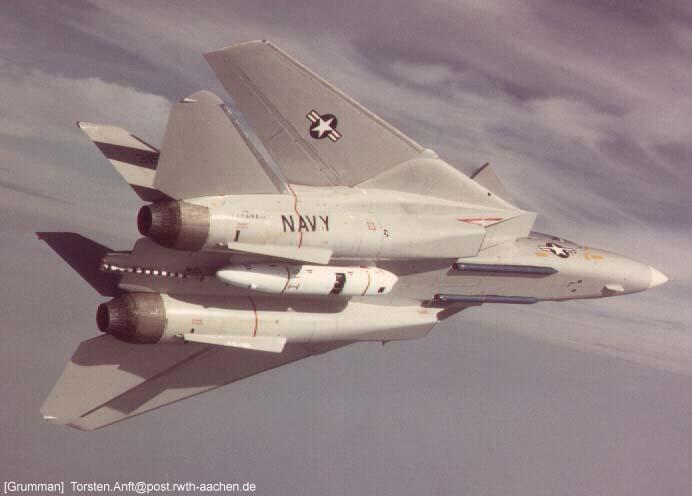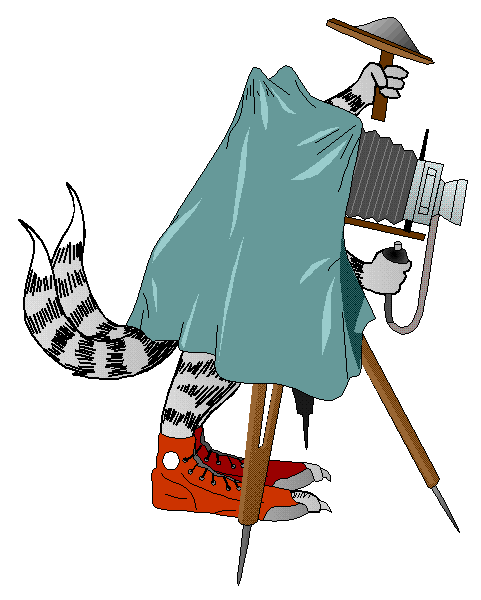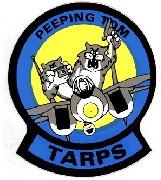

By the mid-1970's the Navy was looking for a new reconnaisance platform to replace the RA-5C Vigilantes and RF-8G Crusaders, which by this time were showing their age. Initial studies looked at a dedicated recon variant of the Tomcat, the RF-14, but by 1974 this was dropped in favour of an 'interim' solution-the T.A.R.P.S. (Tactical Air Reconnaisance Pod System). In the longer term the mission would be taken over by the RF-18 Hornet. However the RF-18 never moved beyond the prototype stage and as a result the 'interim' Tomcat has been fulfilling the recon role for the last 15 years and is likely to continue to do so for another decade.
The TARPS system began development in April of 1976, using a system originally developed for the A-7 Corsair II. Flight testing of the pod began in April 1977, using the no.5 XF-14A (BuNo. 157984). At this stage the pod was carried on the right hand engine nacelle pylon, in place of a drop tank and resembled a squared off version of the drop tank. It also featured fins on the rear (as did early drop tanks). During development the pod was moved to the right rear fuselage station (no. 5) and became more rounded in appearrence. After sucessfully completing testing procurement began in 1978 and was completed by 1984. To carry the pod F-14's had to be specially adapted to the task and as a result 65 F-14A's aircraft were modifed. The changes are confined to a new display in the RIO's station and associated wiring. As a result of being produced after the TARPS pod was in service all F-14D's (both new builds and conversions) were built with the capability to carry the pod. However since entering service a few F-14D's have lost their TARPS capability. These aircraft are all from Block 160 and are now classified as NF-14D's-BuNos:-163412, 163415, 163416 and 163417. Whether all F-14B's (A+) can carry the pod is unclear, at present it seems only selected aircraft are correctly wired for it.


The first deployment of TARPS equipped Tomcat's was by VF-84, the Jolly Rogers, onboard USS Nimtz (CVN-68) in the second half of 1981. This cruise was also notable in that it featured the first blooding of the Tomcat, when two F-14A's of VF-41 Black Aces downed two Libyan Su-22's.
The first deployment of TARPS in the Pacific Fleet was with VF-211 Fighting Checkmates. In a short space of time the capability spread throughout the fleet, until every airwing had one squadron of F-14's equipped for the mission (typically 3 aircraft out of a squadron of 10/12).
When the number of F-14 squadrons in the airwing were cut from 2 to 1 in the mid 1990's it was generally the TARPS capable squadron which survived, the two exceptions being VF-41 (VF-84 was the TARPS squadron in CVW-8) and VF-201 (VF-202 flew TARPS in CVWR-20). Only two squadrons presently flying do not use the TARPS system, these are VF-14 (who fly with VF-41 in CVW-8) and VF-11 (who fly with VF-143 in CVW-7).
| Squadron | History/Present Status |
|---|---|
| VF-2 Bounty Hunters | Initially used F-14A TARPS (1980-94), second Pacific squadron to deploy with TARPS, since 1994 they use the F-14D TARPS. 1997 Westpac cruise was first Pacific Fleet deployment of digital TARPS pod. |
| VF-31 Tomcatters | Initially used F-14A TARPS (1982-92), second Atlantic Fleet squadron to deploy TARPS, after 1992 switched to F-14D TARPS. |
| VF-32 Swordsmen | Initially used F-14A TARPS(1982-97), 1996-7 cruise saw first carrier deployment of digital TARPS pod, in mid-1997 started upgrading to the F-14B TARPS. |
| VF-41 Black Aces | After disestablishment of VF-84 in mid-1995 VF-41 picked up the F-14A TARPS, 1996 cruise saw deployment with digital TARPS pod, the second Atlantic Fleet squadron to do so. |
| VF-84 Jolly Rogers | First squadron to deploy with F-14A TARPS in 1981, used this variant until disestablishment (1981-95). |
| VF-101 Grim Reapers | Uses all TARPS varaints (A, B and D) to train pilots and RIO's in it's use. |
| VF-102 Diamondbacks | Initially used F-14A TARPS (mid 1981-1994), then F-14B TARPS (1994-97), 1997 deployment is their first with the digital TARPS (1997- ) pod and the third for Atlantic Fleet squadrons. |
| VF-103 Sluggers/Jolly Rogers | Initially used F-14A TARPS (1983-89), now uses F-14B TARPS (1989- ). |
| VF-111 Sundowners | Acquired F-14A TARPS in late 1983 and used this variant until disestablishment in March 1995. |
| VF-124 Gunfighters | Initially taught Pacific Fleet crews the TARPS role on F-14A's (198?-94), in 1990 also began teaching TARPS for the F-14D until diestablishment in September 1994. |
| VF-143 Pukin' Dogs | Had acquired F-14A TARPS by 1988, now uses F-14B TARPS (1989- ). |
| VF-154 Black Knights | Acquired F-14A TARPS in 1983 and still uses them today. |
| VF-201 Hunters | After disestablishment of VF-202 in 1995 VF-201 picked up the F-14A TARPS and continues operations with them today. |
| VF-202 Superheats | Used F-14A TARPS from 1987 until disestablishment in 1995. |
| VF-211 Fighting Checkmates | Initially used F-14A TARPS (1980-89) and was first Pacific Fleet squadron to deploy with the type, after 1989 transitioned to the F-14B TARPS, but returned to F-14A TARPS in 1992 and still uses that type today. |
| VF-213 Black Lions | Initially used F-14A TARPS (1982-97), in mid 1997 began transitioning to the F-14D TARPS (1997- ). |
| VF-302 Stallions | Used F-14A TARPS from 1985 until disestablishment in September 1994. |
Initially 65 F-14A's were wired to carry TARPS. A limited number of F-14B's (A+) are correctly wired. All F-14D's can carry TARPS, with a few exceptions (NF-14D's). Below is a comprehensive listing of all known TARPS aircraft, subdivided by Block number.
Clicking on any BuNo. will take you to that aircraft's full service history, clicking on a Block Number will show that Block. An unlinked BuNo. means the aircraft histories for that block have yet to be compiled, as this happens the links will become active.
[Main Page] [F-14A] [F-14B] [F-14D] [Tomcat 21] [Atlantic Fleet Squadron Histories] [Pacific Fleet Squadron Histories] [F-14A Images] [F-14B Images] [F-14D Images] [F-14 Model Kits] [US Navy Air Wings] [A-6 images]